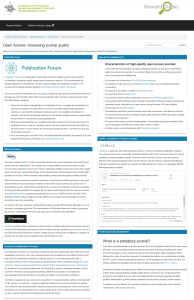During the spring, the Helsinki University Library has published a guide, Assessing open access journal quality, to help researchers find reliable publishers and identify dubious publishers – or predatory publishers. The guide includes checklists and other tools to help you choose a publication channel. There is a section dedicated to the much discussed MDPI and Frontiers publishers.
(Tämä artikkeli on saatavilla myös suomeksi.)

Open access publishing, where a fee is charged for processing an article, has also attracted players whose practices do not meet the criteria of scientific publishing and transparency.
Such publishers sell publishing services to researchers with unrealistic promises. For example, an article may not be published at all, or it may appear after a inadequate peer review. They may also sell membership of a journal’s editorial board or attendance at a non-existent conference.
Some of these dubious publishing channels operate in the grey area, others can be classified as predatory journals or publishers. They are a particular problem for researchers in emerging countries, but the University of Helsinki is no entirely stranger to the phenomenon.
How can a researcher identify such a suspicious publication? Or how can he or she assess the reliability of the journal in the first place? When should the alarm bells go off?
A guide helps to choose a reliable publishing channel
During the spring, the Helsinki University Library has published a guide, Assessing journal quality, to support researchers by providing tools to help them assess the publication channel:
- a checklist describing the characteristics of quality open access journals
- a checklist describing typical features of predatory journals
- the Cabells database, which lists suspicious publications and predatory journals – and transparently presents the evaluation criteria
- A recording of a webinar in English on estimating the quality of open access journals, incuding predatory journals and associated powerpoints
- a service address (openaccess@helsinki.fi) for University of Helsinki researchers to contact about the selection of a publication channel – you can also ask for a presentation of the topic to your unit from the library from the sama address.
The guide also includes links to quality assessment of open access journals, reading recommendations and videos. The MDPI and Frontiers publishers, which have sparked debate at the University of Helsinki, are discussed in a separate section of the guide. There is also a section on the so-called science popularisation services (e.g. Research Outreach, Scientia Global, Innovation News Network, Intech Open and Open Access Government) that have been set up in recent years.
See also the articles on predatory journals and publishers on the Think Open blog:
